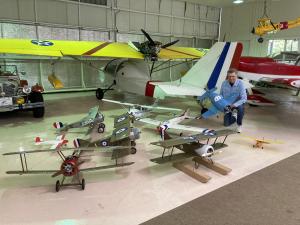
My story begins in 1944. I was 5 years old living with my mother, father, brother, grandparents, aunt, and uncle in a 3-story house in Glen Ridge, New Jersey. I had two uncles in the military, one a Marine in the Pacific and one an Army P-40 mechanic in Hawaii. My teenage uncle at home was an avid artist and craftsman who built model airplanes, built a HO train layout, and drew pictures of P-40s. He was my inspiration.
Having little money, I amused myself carving solid plane models in grammar school and rubber-powered stick models in high school. After 6 years of college, I was finally employed as an electrical engineer and was ready for RC planes. Ten-channel reed systems were the current technology and I went to the local hobby shop to get a plane. The Taurus was a nice looking plane with a good reputation that won the Nats under the guidance of Ed Kazmirski, so I bought it. The build was nice and it came out looking fine.
I joined the Monmouth Model Airplane Club in New Jersey and looked for someone to help me learn to fly it. My instructor who was good on reeds tested the plane and found it airworthy, so on my first flight, he stood by me while I did a few traffic pattern cycles. Very shortly thereafter the plane entered an expanding phugoid resulting in a vertical ground impact. My instructor had turned away to talk to someone else. Good lessons learned.
My real progress began with a new proportional Controlaire RC system and a Falcon 56. Nothing was holding me back now. Through the late 1960s and 1970s, I built planes and competed in Pattern and Scale and some sailplane and club racing and was a leader in my club. Great fun. Our club was very active with 80 to 100 members over the years. There was great camaraderie among the club competitors who would attend contests in New Jersey, New York, Pennsylvania, Delaware, and Connecticut.
As the end of the 1970s came along, new technologies such as helicopters, large and more powerful planes, and an interest in fun-flys attracted flyers away from the classic modes of competition, which tended to dissolve the high common interests of the members.
Come the 1980s, and I decided to get my pilot's license and quickly got an instrument rating and Commercial license. This put modeling on hold for about 4 decades. During that time, I built an ultrilight, two amphibian SeaReys, and an IFR RV-9.
Five years ago, I got back into the RC hobby and realized how much the world had changed. My old 72 MHz systems were scrapped and I looked for a plane to build. The hobby shop doesn’t look like the ones I used to know. Everything seems to be nice looking foam, ready-to-fly planes with all kinds of electronic features and aids. The guys and gals were having fun with them but that is not where my heart was.
I wanted to build 1/6-scale WW I biplanes. I searched RC Groups and Ebay to find old kits that had been laying around collecting dust for years. I also had a bunch of glow fuel engines that were perfectly good that I wanted to use so that defined my thrust back into the hobby.
My current fleet of around 20 consists of mostly glow fuel-powered, kit-built aircraft, some conversions to electric power, a glider, and an .049 powered QT from 50 years ago, both still flying. I did give in to a couple of scale electric foamies that brought back memories, a P-40 “Flying Tiger” and an F4U Corsair.
Model building is in my blood, and I am sorry to see that part of the hobby overtaken by the beautiful and cheap Chinese foam ready-to-fly alternatives that have driven almost all the legacy kit manufacturers out of business. Our kids need to get their hands dirty more as an impetus to rebuilding American manufacturing.


